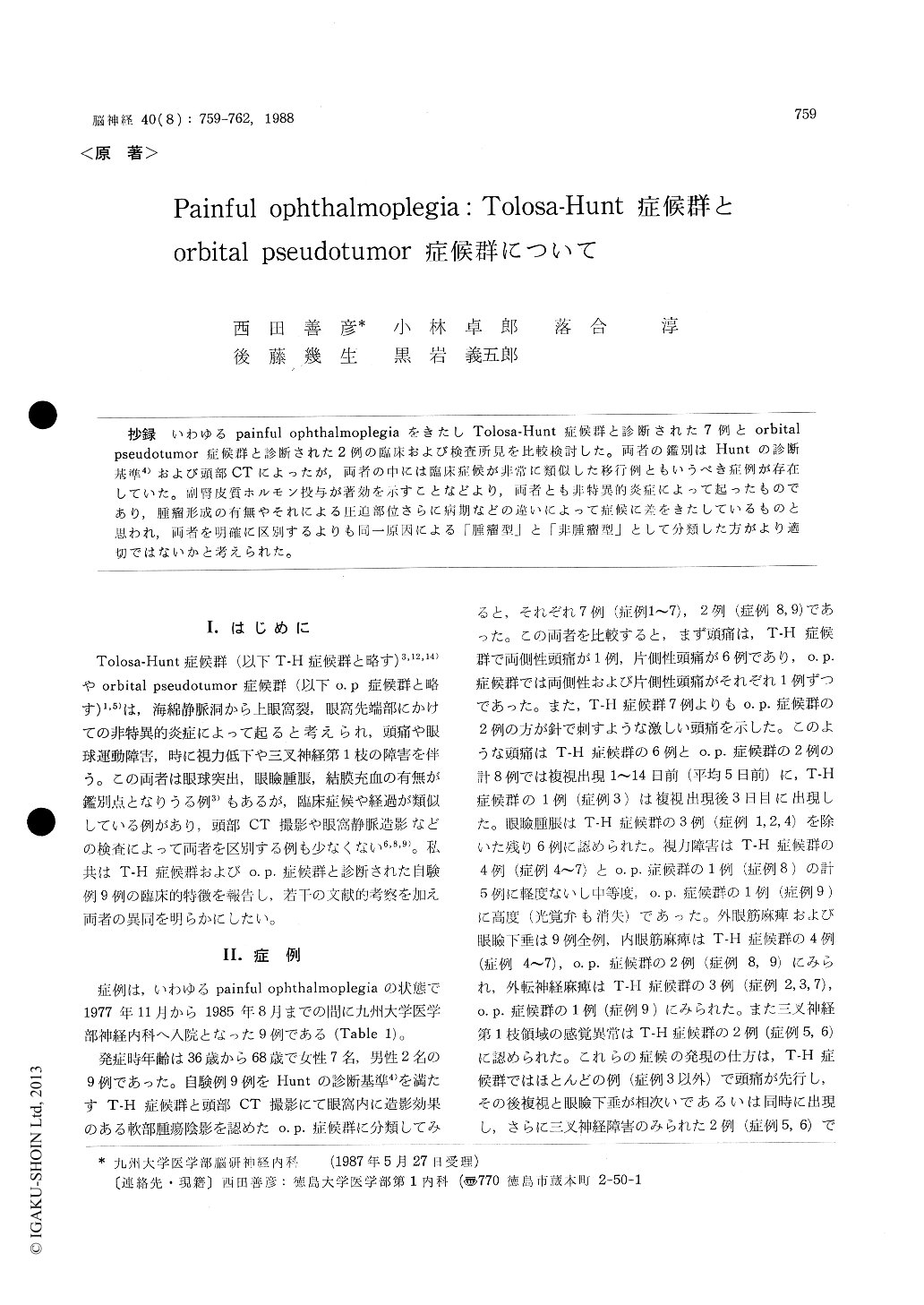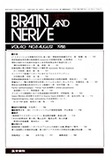Japanese
English
- 有料閲覧
- Abstract 文献概要
- 1ページ目 Look Inside
抄録 いわゆるpainful ophthalmoplegiaをきたしTolosa-Hunt症候群と診断された7例とorbitalpseudotumor症候群と診断された2例の臨床および検査所見を比較検討した。両者の鑑別はHuntの診断基準4)および頭部CTによったが,両者の中には臨床症候が非常に類似した移行例ともいうべき症例が存在していた。副腎皮質ホルモン投与が著効を示すことなどより,両者とも非特異的炎症によって起ったものであり,腫瘤形成の有無やそれによる圧迫部位さらに病期などの違いによって症候に差をきたしているものと思われ,両者を明確に区別するよりも同一原因による「腫瘤型」と「非腫瘤型」として分類した方がより適切ではないかと考えられた。
We experienced 9 patients with "painful oph-thalmoplegia", which included 7 cases of the Tolosa-Hunt syndrome (2 males and 5 females, with ages ranging from 36 to 65 years) and 2 cases of the orbital pseudotumor syndrome (2 females aged 42 and 68). The diagnosis of these syndromes was based upon Hunt's criteria and the presence of the intraorbital mass on the brain CT scan.
Main manifestations of both syndromes were periorbital pain and ipsilateral oculomotor nerve palsies. Out of 9 cases, 1 patient with Tolosa-Hunt syndrome and 1 patient with the orbital pseudo-tumor syndrome had bilateral retro-orbital pain and ophthalmoplegia. Pain preceded the ophthal-moplegia except in one patient with Tolosa-Hunt syndrome. Total paralysis of the extraocular mus-cles supplied by the oculomotor nerve was noted in all the nine patients, and mydriasis was obser-ved on the affected side in 4 of 7 patients withTolosa-Hunt syndrome and 2 patients with the orbital pseudotumor syndrome. Neurological in-volvement was not only the oculomotor nerve but also the other cranial nerves ; the optic nerve (in 4 cases with Tolosa-Hunt syndrome and 2 cases with the orbital pseudotumor syndrome), the abducens nerve (in 3 cases with Tolosa-Hunt syndrome and 1 case with the orbital psudotumor syndrome), and the first division of the trigeminal nerve (in 2 cases with Tolosa-Hunt syndrome). Six patients with Tolosa-Hunt syndrome and 2 patients with the orbital pseudotumor syndrome had palpebral edema. Visual disturbance and palpebral edema were severer in the patients with the orbital pseudotumor syndrome. After corticosteroid hormone was administered, there was a diminution of the pain within 2 weeks. But the recovery from cranial nerve palsies had a tendency to be delayed. Laboratory examina-tions such as erythrocyte sedimentation rate, WBC count and CRP showed almost normal in all the 9 patients. Two patients of Tolosa-Hunt syn-drome with visual disturbance had enlargement of optic nerve shadow on brain CT and obstru-ction of superior orbital vein at the third portion on orbital venography. Brain CT showed intraor-bital soft tissue density mass and compression of optic nerve in the orbital pseudotumor syndrome.
Many symptoms and laboratory findings were similar between the two syndromes and there were a few cases with transitional form. The treatment of corticosteroid hormone was effective in both syndromes, suggesting that both syndro-mes are caused by a non-specific inflammation. The different clinical appearance of the two syn-dromes may be due to the different sites of lesion and clinical stages. Therefore, it must be better to classify the "painful opthalmoplegia" into "pseudotumor type" and "non-tumor type," by the finding of CT scan.

Copyright © 1988, Igaku-Shoin Ltd. All rights reserved.


